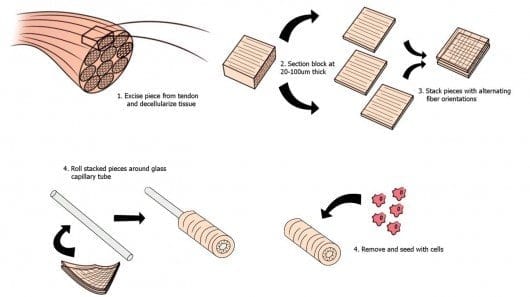
The result is a collagen scaffolding that is stronger than that produced by conventional processes.
Collagen is the main component of connective tissues and the most abundant protein in the human body. Biocompatible and biodegradable, it is an excellent material for making scaffolding for tissue engineering. The trouble is, conventional techniques disrupt the fibrous structure of collagen and weaken the end product. At the Tufts University School of Engineering, Qiaobing Xu, assistant professor of biomedical engineering, and Ph.D. student Kyle Alberti have developed a new technique for fabricating collagen structures that avoids this disruption and retains collagen’s strength.
Invented by Xu, the new technique is called “bioskiving.” It involves taking collagen from bovine tendons and removing all the cells and other materials from it using special detergents until only the collagen fibers are left. These are then sliced into very thin sheets using a microtome and stacked in layers of ten at right angles to one another like layers of plywood.
The result is a collagen scaffolding that is stronger than that produced by conventional processes. This scaffolding can also be formed into tubes by folding the sheets around a Teflon-coated glass rod. These tubes are also stronger than those produced by conventional techniques. These structures can then be seeded with living cells to create blood vessels and other products.
via Gizmag – David Szondy
The Latest Streaming News: Tissue engineering updated minute-by-minute
Bookmark this page and come back often
Latest NEWS
Latest VIDEO







